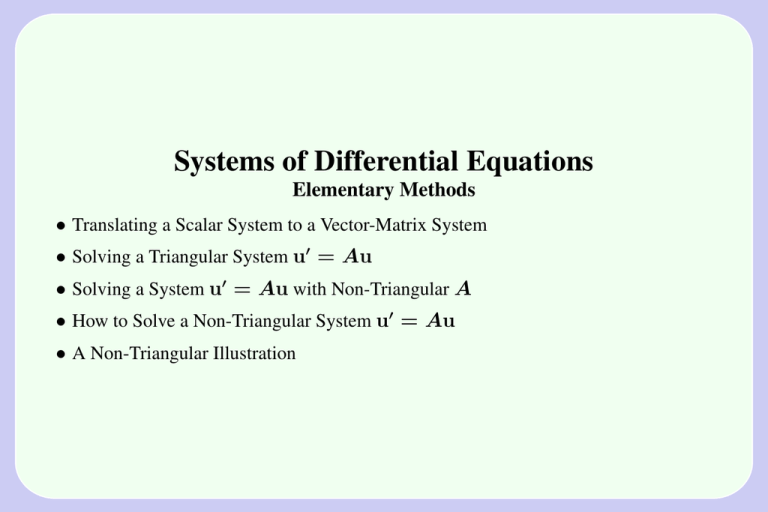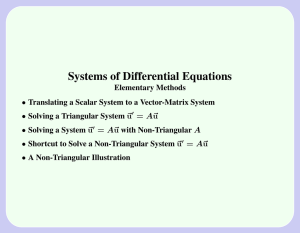Systems of Differential Equations Elementary Methods • u
advertisement

Systems of Differential Equations Elementary Methods • Translating a Scalar System to a Vector-Matrix System • Solving a Triangular System u0 = Au • Solving a System u0 = Au with Non-Triangular A • How to Solve a Non-Triangular System u0 = Au • A Non-Triangular Illustration Translating a Scalar System to a Vector-Matrix System Consider the scalar system u01(t) = 2u1(t) + 3u2(t), u02(t) = 4u1(t) + 5u2(t). Define u= u1(t) u2(t) , A= 2 3 4 5 . Then matrix multiply rules imply that the scalar system is equivalent to the vector-matrix equation u0 = Au Solving a Triangular System An illustration. Let us solve u0 = Au for a triangular matrix A= 1 0 2 1 . The matrix equation u0 = Au represents two differential equations: u01 = u1, u02 = 2u1 + u2. The first equation u01 = u1 has solution u1 = c1 et . The second equation becomes u02 = 2c1et + u2, which is a first order linear differential equation with solution u2 = (2c1 t + c2 )et . The general solution of u0 = Au is u1 = c 1 e t , u2 = 2c1te−t + c2et. Solving a System u0 = Au with Non-Triangular A a b Let A = be non-triangular. Then both b 6= 0 and c 6= 0 must be satisfied. c d The scalar form of the system u0 = Au is u01 = au1 + bu2, u02 = cu1 + du2. Theorem 1 (Solving Non-Triangular u0 = Au) Solutions u1 , u2 of u0 = Au are linear combinations of the list of atoms obtained from the roots r of the quadratic equation det(A − rI) = 0. Proof of the Non-Triangular Theorem The method is to differentiate the first equation, then use the equations to eliminate u2 , u02 . This results in a second order differential equation for u1 . The same differential equation is satisfied also for u2 . The details: u001 = = = = au01 + bu02 au01 + bcu1 + bdu2 au01 + bcu1 + d(u01 − au1) (a + d)u01 + (bc − ad)u1 Differentiate the first equation. Use equation u02 = cu1 + du2 . Use equation u01 = au1 + bu2 . Second order equation for u1 found The characteristic equation is r 2 − (a + d)r + (bc − ad) = 0, which is exactly the expansion of det(A − rI) = 0. The proof is complete. How to Solve a Non-Triangular System u0 = Au • Finding u1. The two roots r1, r2 of the characteristic equation produce two solution atoms, In case the roots are distinct, the solution atoms are er1 t , er2 t . Then u1 is a linear combination of atoms: u1 = c1 er1 t + c2 er2 t . • Finding u2. Isolate u2 in the first differential equation by division: u2 = 1 b (u01 − au1). The two formulas for u1 , u2 represent the general solution of the system u0 = Au, when A is 2 × 2. A Non-Triangular Illustration Let us solve u0 = Au when A is the non-triangular matrix A= 1 2 2 1 . The characteristic polynomial is det(A − rI) = (1 − r)2 − 4 = (r + 1)(r − 3). Euler’s theorem implies solution atoms e−t , e3t . Then u1 is a linear combination of the solution atoms, u1 = c1 e−t + c2 e3t . The first equation u01 = u1 + 2u2 implies u2 = 1 (u01 − u1) 2 = −c1e−t + c2e3t. The general solution of u0 = Au is then u1 = c1e−t + c2e3t, u2 = −c1e−t + c2e3t.









